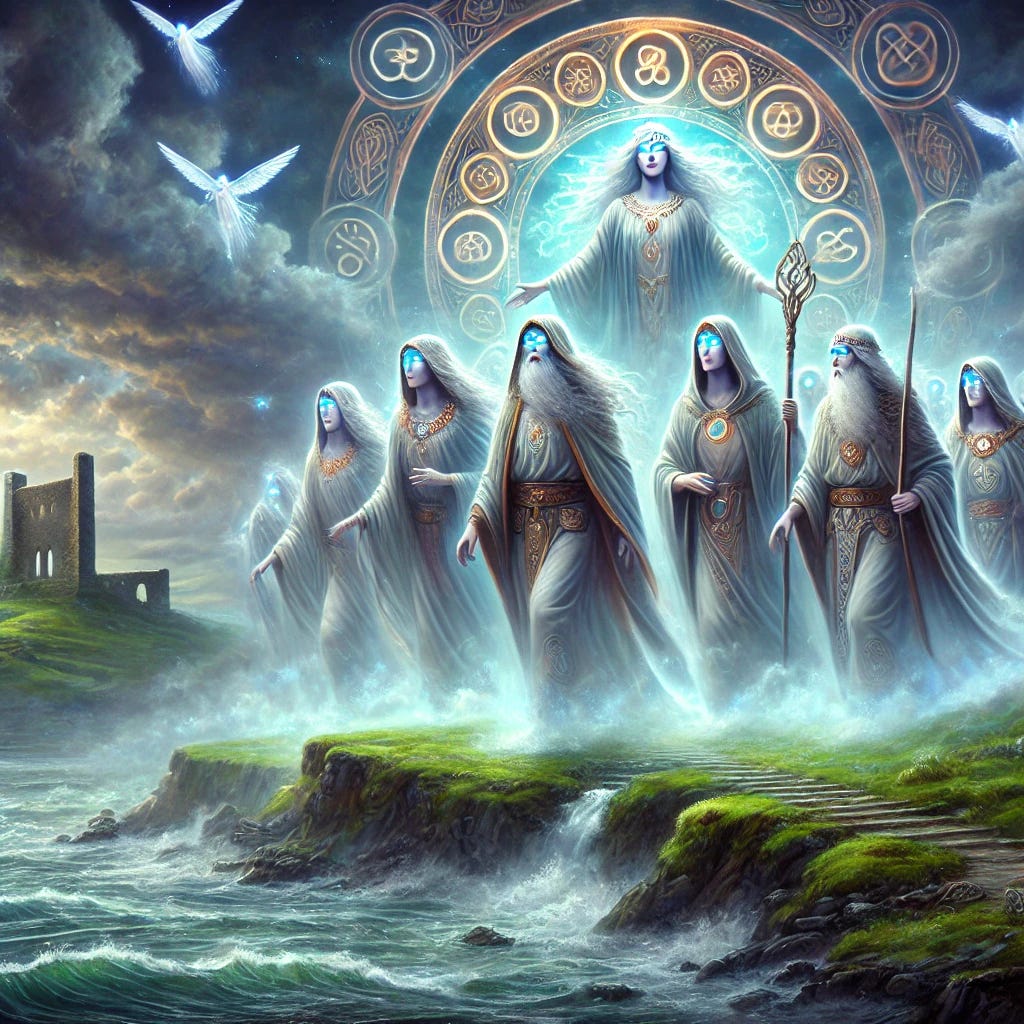Ireland’s ancient history is filled with myth, legend, and mystery. Long before the arrival of the Celts, the island was said to be home to several waves of settlers, each with their own incredible stories of conquest, survival, and supernatural abilities. According to Irish mythological traditions, particularly the Lebor Gabála Érenn (The Book of Invasions) and Historia Britonum, the first inhabitants of Ireland were not the Gaels, but earlier peoples like the Partholónians, the Nemedians, the Fir Bolg, and the legendary Tuatha Dé Danann. This blog post explores these mythical early settlers and their fascinating legacies.
Partholón and His People: The First Settlers
The first recorded settlers of Ireland, according to legend, were the people of Partholón. He was said to be a descendant of Japheth, the son of Noah, and he led a group of followers from the east, eventually arriving in Ireland 300 years after the Great Flood.
When Partholón and his people arrived, Ireland was described as a wild, barren, and uninhabited land with only three lakes and nine rivers. Under their influence, the land flourished. They introduced agriculture, cattle herding, brewing, and even the first laws and governance.
Not long after settling, the Partholónians encountered the Fomorians, a monstrous, semi-divine race that lived off piracy and plundering. The Fomorians were often depicted as sea raiders, deformed giants, or supernatural beings who opposed all new settlers in Ireland. Partholón's people waged war against them and were victorious in several battles.
Despite their successes, the entire Partholónian people were wiped out by a devastating plague, leaving Ireland empty once again. Some versions of the legend say that only one man survived to tell their tale.
The Nemedians: The Second Wave of Settlers
After the destruction of the Partholónians, Ireland remained uninhabited for another 200 years until the arrival of Nemed and his people. Nemed was said to have come from Scythia or Greece, leading a new group of settlers to Ireland.
Just like the Partholónians before them, the Nemedians faced the wrath of the Fomorians. However, this time, the Fomorians had grown even more powerful and cruel, imposing harsh tributes on the settlers. The Nemedians attempted to rise against them but suffered heavy losses.
After years of struggle, the surviving Nemedians either perished or fled. Some accounts say they went to Britain and became the ancestors of the Britons, while others traveled to Greece and Spain, eventually becoming the Fir Bolg and the Tuatha Dé Danann—two of the most famous races in Irish mythology.
The Fir Bolg: The Oppressed People Who Became Warriors
The Fir Bolg were the descendants of Nemedians who had fled to Greece, where they were enslaved for many years. Eventually, they escaped and made their way back to Ireland, ready to claim the land for themselves.
Unlike the previous groups, the Fir Bolg were better organized and immediately divided Ireland into five provinces, creating a system of governance. They ruled the island for a time under their High King Eochaid Mac Eirc, until they encountered a new and even more powerful enemy—the Tuatha Dé Danann.
The Tuatha Dé Danann: The Gods of Irish Mythology
The most legendary inhabitants of Ireland were the Tuatha Dé Danann, often described as divine beings with incredible powers. Some legends suggest they were gods, while others depict them as an advanced race with magical knowledge.
The Tuatha Dé Danann were said to have come from the northern islands of the world, bringing with them four sacred treasures:
The Stone of Destiny (Lia Fáil) – A magical stone that cried out when the true king of Ireland stood upon it.
The Spear of Lugh – A deadly weapon that ensured victory in battle.
The Sword of Nuada – A blade that could cut through anything.
The Cauldron of Dagda – A vessel that provided endless food.
They arrived in Ireland in a mystical fashion, supposedly descending from the sky in a great mist, which some interpret as a metaphor for arriving by ship or possessing advanced technology.
Once in Ireland, the Tuatha Dé Danann demanded sovereignty. The Fir Bolg refused, leading to the First Battle of Mag Tuired. Though the Fir Bolg fought bravely, they were ultimately defeated. However, they were granted the province of Connacht as a gesture of respect.
The Tuatha Dé Danann established their rule under their first king, Nuada, but during the battle with the Fir Bolg, he lost his arm. Since Irish law required a king to be physically whole, Nuada was replaced by Bres, a half-Fomorian ruler who turned out to be cruel and unjust. Eventually, the Tuatha Dé Danann restored Nuada to power after giving him a magical silver arm.
Their greatest battle came against the Fomorians, who had once again returned to challenge the new rulers of Ireland. The Second Battle of Mag Tuired was fought between the Tuatha Dé Danann, led by the hero Lugh, and the Fomorian king Balor of the Evil Eye, a monstrous being whose gaze could kill. Lugh ultimately slew Balor, ensuring the supremacy of the Tuatha Dé Danann over Ireland.
Though victorious, the Tuatha Dé Danann’s reign would not last forever. A new group, the Milesians, descendants of the Gaels from Spain, arrived in Ireland. After a series of battles and negotiations, the Tuatha Dé Danann agreed to retreat into the Otherworld, becoming the Sídhe—the fairy folk of Irish mythology. They were believed to have gone underground, living in mounds and magical realms, watching over Ireland from the shadows.
Conclusion
The early legends of Ireland tell of an island fought over by supernatural beings, warrior tribes, and wandering exiles. The Partholónians, the Nemedians, the Fir Bolg, and the Tuatha Dé Danann each played a role in shaping the land before the arrival of the Gaels. Whether these stories are pure myth or contain echoes of real prehistoric migrations, they remain a fascinating part of Ireland’s cultural heritage.




